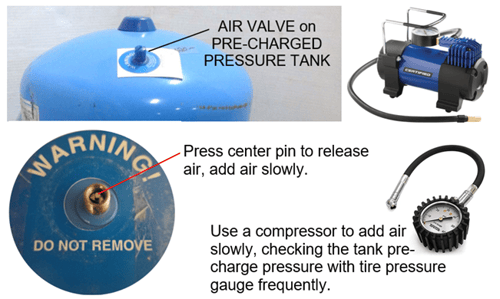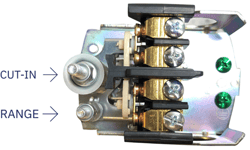What PSI should a tanks Pre-Charge Pressure be set to?
What PSI should a tanks Pre-Charge Pressure be set to?
Ho to adjust a tanks Pre-Charge Pressure

#1 - Remove the protective air valve cap and check the pre-charge pressure using a suitable pressure gauge. The tank should be at room temperature and must be completely drained to ensure it is empty of water.
#2 - Pressure tank and pressure switch installation instructions will often advise to release or add air as necessary to make the pre-charge pressure equal to 2 PSI minimum below the pressure switch cut in setting. However, the 2 PSI is the minimum for a 20-40 switch, it is not enough for a 40-60 switch which should be 6 PSI below. Some information suggests that 10% - 20% below the pressure switch cut-in setting is a suitable range. We suggest that the mid-range of 15 % will be sufficient to minimize problems due to small inaccuracies between the system pressure gauge and the air pressure gauge you are using, as well as changes in ambient temperature as seasons change. The chart below provides the suggested tank pre-charge based on the common pressure switch cut-in settings.

 Note: Pressure switch settings may be out-of-adjustment. For example, if labeled 30/50, it may be 28 or 29 to 48 or 49. See how to adjust your pressure switch using the link below:
Note: Pressure switch settings may be out-of-adjustment. For example, if labeled 30/50, it may be 28 or 29 to 48 or 49. See how to adjust your pressure switch using the link below:
How do I adjust the CUT-IN and CUT-OUT settings of a Pressure Switch? (boshart.com)
